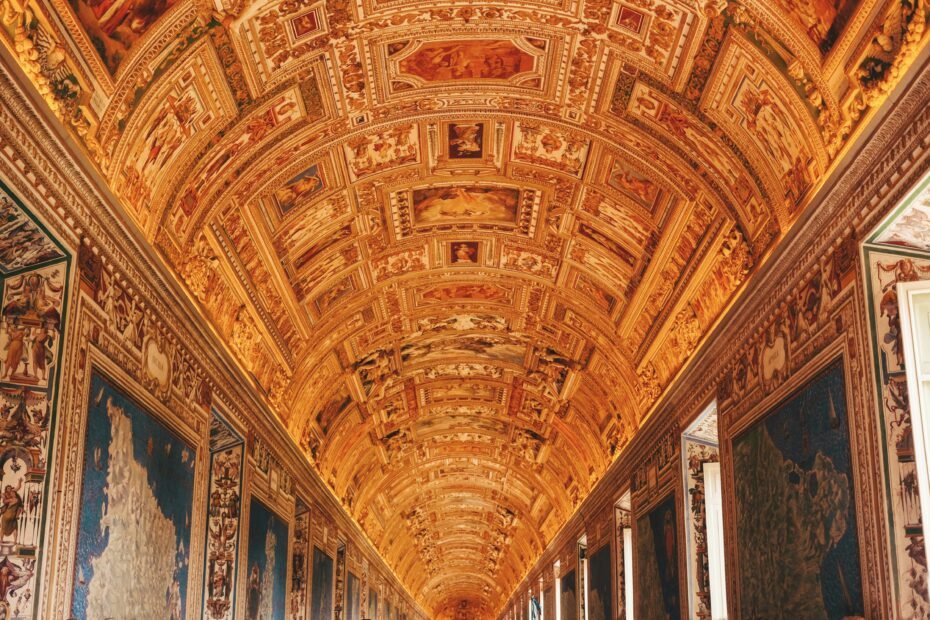The Vatican Museums (Musei Vaticani), among the most famous museums in the world, house an unparalleled collection of art, history, and culture curated over centuries by the Catholic Church. A visit is a must for anyone exploring Rome. Here’s a comprehensive guide for tourists:
Overview
- Established: 1506 by Pope Julius II.
- Location: Within Vatican City, the smallest country in the world.
- Collections: Over 20,000 pieces of art and artifacts on display, with a collection spanning ancient Egypt, classical antiquity, Renaissance masterpieces, and contemporary works.
- Famous for: The Sistine Chapel, Raphael Rooms, and the Gallery of Maps.
What to See
- The Sistine Chapel:
- Ceiling Frescoes: Painted by Michelangelo between 1508–1512, featuring the iconic Creation of Adam.
- The Last Judgment: A powerful fresco by Michelangelo on the chapel’s altar wall.
- Usage: Still serves as the site of the Papal Conclave, where popes are elected.
- The Raphael Rooms (Stanze di Raffaello):
- A series of rooms was decorated by Raphael and his students.
- Famous frescoes include The School of Athens, symbolizing philosophy and learning.
- Gallery of Maps (Galleria delle Carte Geografiche):
- A stunning 120-meter-long corridor adorned with 16th-century maps of Italy.
- One of the most photographed sections of the museum.
- Pinacoteca Vaticana (Vatican Art Gallery):
- Features masterpieces by artists such as Raphael, Leonardo da Vinci, Caravaggio, and Titian.
- Pio Clementino Museum:
- A treasure trove of classical antiquities, including the famous Laocoön and His Sons sculpture.
- Egyptian Museum:
- Houses artifacts like mummies, sarcophagi, and statues from ancient Egypt.
- Etruscan Museum:
- Showcases objects from the ancient Etruscan civilization, including jewelry, pottery, and weapons.
- Modern Religious Art Collection:
- Features works by artists such as Salvador Dalí, Vincent van Gogh, and Pablo Picasso.
- Vatican Gardens (optional, separate tour):
- Beautifully landscaped gardens with fountains, sculptures, and quiet paths.
How to Visit
- Tickets:
- Online Booking: Highly recommended to avoid long lines.
- Types of Tickets:
- General Admission: Includes access to all museum galleries and the Sistine Chapel.
- Guided Tours: Provide expert commentary and skip-the-line privileges.
- Early Access or Night Tours: Offer quieter experiences before or after regular hours.
- Entrance:
- Location: Main entrance on Viale Vaticano.
- Entry is separate from St. Peter’s Basilica, though a connection exists via the Sistine Chapel.
- Opening Hours:
- Monday to Saturday: 9 AM – 6 PM (last entry at 4 PM).
- It is closed on Sundays, except the last Sunday of the month, when admission is free (and often crowded).
- Duration:
- Allocate 3–4 hours to explore the highlights; art enthusiasts may need a full day.
Tips for Tourists
- Plan Ahead:
- Purchase tickets in advance to avoid lines.
- Choose morning slots for a quieter experience.
- Dress Code:
- Since it’s a religious site, modest attire is required (no shorts above the knee, sleeveless tops, or hats).
- Wear Comfortable Shoes:
- The museum involves extensive walking through long corridors and staircases.
- Photography:
- Allowed in most galleries but strictly prohibited in the Sistine Chapel.
- Food and Drink:
- Cafés are available inside the museum, but eating or drinking in the galleries is prohibited.
- Guided Tours:
- Consider a tour to understand the historical and artistic context of key pieces.
Getting There
- By Metro:
- Take Line A to Cipro or Ottaviano station, a 5–10 minute walk from the entrance.
- By Bus:
- Several bus routes stop near the Vatican, including #49, #492, and #990.
- By Taxi:
- Drop-off points are near the entrance, but traffic can be heavy.
Nearby Attractions
- St. Peter’s Basilica:
- Accessible after the Sistine Chapel via a reserved exit for visitors.
- Features Michelangelo’s Pietà and Bernini’s Baldachin.
- St. Peter’s Square:
- The iconic plaza with its colonnades and Egyptian obelisk.
- Castel Sant’Angelo:
- A short walk away, offering panoramic views of the city.
Fun Facts
- The Vatican Museums span over 9 miles of galleries, making them one of the largest museum complexes in the world.
- Michelangelo painted the Sistine Chapel ceiling lying on his back, contrary to the popular myth—he actually stood on a scaffold.
- The museum welcomes over 6 million visitors annually, making it one of the most visited art museums globally.
Best Time to Visit
- Avoid Crowds:
- Visit early in the morning or late in the afternoon.
- Avoid weekends, especially during peak tourist seasons (spring and summer).
- Special Events:
- Check for special exhibitions or extended hours.
Accessibility
- Wheelchair Accessible: Elevators and ramps are available.
- Wheelchairs can be borrowed for free at the entrance.
Cultural Significance
The Vatican Museums are not only a testament to the Catholic Church’s patronage of art but also a celebration of human creativity across cultures and centuries. They are a bridge between the past and present, showcasing treasures that have shaped Western civilization and beyond.
Conclusion
A visit to the Vatican Museums is a journey through time, art, and spirituality. From Michelangelo’s breathtaking frescoes to ancient sculptures and Renaissance masterpieces, the museums offer an unparalleled experience. Plan well, take your time, and immerse yourself in one of the world’s richest cultural troves.
